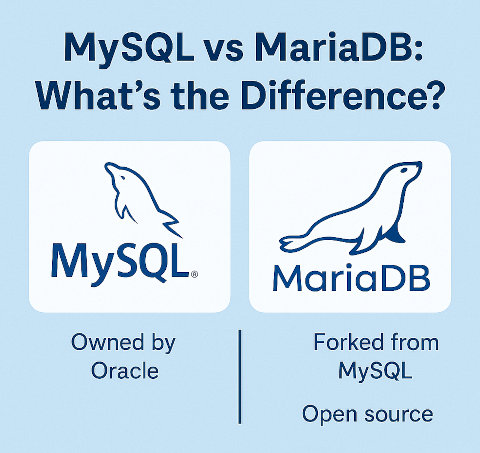MySQL vs MariaDB: What's the Difference?
Trying to decide between MySQL and MariaDB for your next website or web app project? These two relational database systems are closely related but have several differences that could impact performance, licensing, features and community support. In this post, we'll explore how MySQL and MariaDB stack up, so that you can make the best choice for your website or app.

MySQL and MariaDB are both popular open-source relational database management systems (RDBMS) used by developers, businesses and web applications worldwide. While they share many similarities due to a common origin, they have diverged in recent years in terms of features, performance, licensing and community support. Understanding their differences is crucial when choosing the right one for your project, before you start.
What Are MySQL and MariaDB?
MySQL was originally developed by MySQL AB in the mid-1990s and is now owned by Oracle Corporation. It is widely known for its stability and is used in numerous applications like WordPress, Joomla and Drupal.
MariaDB is a fork of MySQL, created by the original developers after Oracle acquired MySQL. It aims to remain fully open-source and community-driven while maintaining compatibility with MySQL, especially in the early versions.
Key Differences Between MySQL and MariaDB
1. Licensing
MySQL is distributed under the dual licensing model, open-source (GPL) and commercial licenses managed by Oracle. This means some enterprise-level features may only be available under a commercial license.
MariaDB is 100% GPL licensed and free to use. There are no commercial restrictions, which appeals to developers and businesses concerned about vendor lock-in.
2. Development and Community
Oracle maintains MySQL development. Updates are controlled and released by Oracle, sometimes with limited visibility into the development roadmap.
Community-driven with active participation from independent developers and companies. The MariaDB Foundation promotes transparency, rapid development and open collaboration.
3. Performance Enhancements
MariaDB includes several performance improvements over MySQL:
- More storage engines (e.g., Aria, ColumnStore, MyRocks)
- Faster replication via parallel threads
- Improved optimizer and query performance
- Advanced caching mechanisms
While MySQL is fast and reliable, MariaDB focuses on introducing newer enhancements quicker.
4. Features and Extensions
Both databases support standard SQL syntax and ACID compliance. However, MariaDB often includes additional features not yet available in MySQL, such as:
- Virtual columns
- Thread pool support in community edition
- Extended statistics and analysis tools
- Pluggable storage engines
MySQL, meanwhile, provides better integration with Oracle tools and has specific features for enterprise environments like Group Replication and InnoDB Cluster.
5. Compatibility
In general, MariaDB remains a drop-in replacement for MySQL up to version 5.5. However, as both systems evolve, differences in syntax, configuration, and internal mechanics are becoming more noticeable, especially in version 10.5+ of MariaDB.
If your application depends on very specific MySQL features introduced in recent Oracle releases, switching to MariaDB may require additional testing.
Use Cases for MySQL
- You need official enterprise support from Oracle.
- You use tools that are tightly integrated with MySQL, like MySQL Workbench.
- You work in corporate environments where commercial licenses and certifications are necessary.
Use Cases for MariaDB
- You prefer open-source software with no licensing fees.
- You want faster innovation and community-driven development.
- You require advanced storage engines like ColumnStore or Aria.
- You need performance tuning beyond what MySQL currently offers.
Security Considerations
Both MySQL and MariaDB offer robust security features, including SSL encryption, user management, and role-based permissions. However, MariaDB often patches vulnerabilities more transparently due to its open development model. MySQL users may need to wait for Oracle to release fixes or rely on subscription-based updates.
Replication and Clustering
Both systems support replication - including master-slave and multi-source. MariaDB has more options available for clustering with its Galera Cluster integration, while MySQL offers Group Replication and InnoDB Cluster.
Performance Benchmarks
While exact performance will vary based on workloads, many benchmarks suggest MariaDB performs slightly better in read-intensive environments due to improvements in query optimization, caching and indexing.
Tools and Ecosystem
Both databases are compatible with standard clients like phpMyAdmin, DBeaver and MySQL client libraries. However, certain MySQL-specific tools may not fully support MariaDB and vice versa.
Choose MySQL if: You need guaranteed long-term support from Oracle, use enterprise-grade tools, or prefer conservative upgrade paths.
Choose MariaDB if: You value open-source principles, want advanced performance tuning or need features Oracle has not yet adopted.
Ultimately, both systems are powerful and production-ready. The right choice depends on your licensing preferences, performance requirements and how much flexibility you want in your deployment environment.
